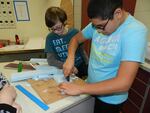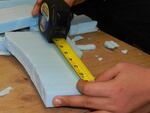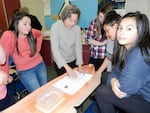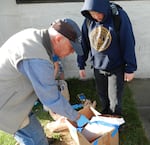
Seventh graders Michael Herrera and Nicolas Barbee cut foam for the model boat's hull.
Jes Burns/EarthFix
Seventh graders Michael Herrera and Nicholas Barbee are preparing for a maritime journey.
One-inch thick sheets of green foam lie in front of them. The foam is usually used to insulate walls, but today the boys are cutting it to fill the hull of a model boat about 5 feet long. They want the foam to fight tightly.
“We’re going to cut it in thirds or half?” Barbee asks.
“Just half,” answers Herrera.

Michael Herrera fits foam into the hull of the future "SS Dolphin."
Jes Burns/EarthFix
The students are working on a class project at Sunset Middle School in Coos Bay, Oregon. They’re building a boat that will be launched this March by a research vessel with the National Oceanic and Atmospheric Administration. It will set the student-built model afloat off the coast of South America. Then the students can track the boat’s journey that could take it across the Pacific Ocean to Asia and beyond.
Mathematical and spatial problem solving are just par for the course for the project – as are as some more complex physics concepts.
“Buoyancy is actually very important in a boat. If it doesn’t have buoyancy, it won’t last long in the water,” Barbee says.

Coos Bay students work on science, math, engineering and technology skills through the Educational Passages program.
Jes Burns/EarthFix
“We’ve got things like scale drawings going on. Learning about GPS tracking, about satellites and things like that are all things we’re learning about in our classroom,” Giniger says.
Elements of oceanography, earth science and geography also sneak into the discussion – as well as the arts.
Elvia Ruiz uses the class whiteboard to design text and graphics for the boat. So far the plan is to paint it with the school’s mascot.
“We’re going to make water coming out of it. And then the dolphin at the top.” she explains.
Andrew Giniger says the project came to Sunset Middle through the Oregon Coast STEM Hub, which helps coordinate science, technology, engineering and math projects at schools.

Sunset Middle students work with a volunteer from the Coos Bay Boat Building Center to create graphic for their model.
Jes Burns/EarthFix
The Coos Bay school is one of a handful on the West Coast participating in the Educational Passages boat-building program. A high school in Waldport, Oregon launched their boat in November. It’s currently adrift southwest of Baja, heading towards Hawaii.
“This (is) project-based learning, which really lets the kids kind of guide their own learning. They seem to be almost everybody totally engaged in whatever they’re doing,” Giniger says.
'Totally engaged' might be a bit of an overstatement.
“It’s chaos!” says Bob Sasanoff, one three volunteers from the Coos Bay Boat Building Center who are working with the class.
“And you know what they say about chaos… it’s an organization that you don’t understand.”

A classroom volunteer explains the importance of a keel in boat construction to Coos Bay middle school student Logan Ford.
Jes Burns/EarthFix
Bewilderment aside, Sasanoff has been guiding assembly of the boat.
“It’s really just sort of standing back and letting them do what they’re doing – make sure they really own what’s going on,” he says.
And taking ownership they are. With the construction deadline looming, a couple kids volunteer to come in after school to finish, to the delight of their teacher Andrew Giniger.
“You see that they’re involved. You see that they’re learning," he says. "It’s just been an amazing eye-opener to me.”
